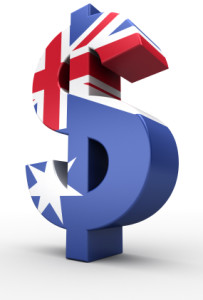AUD/USD has ticked higher on Thursday. In the North American session, the pair is trading at 0.7670. Earlier in the day, AUD/USD climbed to 0.7732, its highest level since August 15. On the release front, Australian Trade Balance narrowed to A$2.41 billion, better than the forecast of A$2.61 billion. Later in the day, Australia releases Home Loans. In the US, unemployment claims dropped to 259 thousand, beating the estimate of 264 thousand. This reading marked the lowest level for jobless claims in seven weeks.
Australian GDP failed to keep pace in the second quarter, as the gain of 0.5% was just half of the Q1 release of 1.1%. Still, this figure was just shy of the forecast of 0.6%, enabling the Aussie to hold its own on Wednesday. Earlier this week, the RBA maintained rates at 1.50%, as expected. The bank has not hesitated to pull the rate trigger, lowering rates twice in 2016. In the RBA rate statement, Governor Glenn Stevens said that the bank expects low inflation to continue. Stevens also paid note to the appreciating Australian dollar, which he said could “complicate” the economic recovery. The RBA has made no secret that it prefers a lower exchange rate, and a strong Aussie coupled with low inflation could be a recipe for another rate cut before the end of 2016.
Back in August, Fed chair Janet Yellen said that the case in favor of a rate hike had improved, given stronger US data. Ever since that speech in Jackson Hole, the markets have been fixated on the possibility of a rate hike prior to the end of 2016. However, a spate of weak US numbers in the past week has lowered the likelihood of a move by the Fed. The CME FedWatch Tool is showing a substantial drop in the odds of a rate hike for both September and December – the likelihood of a September rise has dropped to 15%, while the odds of a December hike are down to 39%. Even though the US labor market remains close to full capacity, many FOMC members remain uneasy about a rate hike, especially given the persistent lack of inflation in the economy. Key inflation indicators will be released in mid-September, just before the Fed policy meeting on September 21. These releases could play a critical role in determining if the Fed presses the rate trigger this month, or decides to revisit the rate question in December, exactly a year from the last rate hike.
AUD/USD Fundamentals
Wednesday (September 7)
- 21:30 Australian Trade Balance. Estimate -2.65B. Actual -2.41B
Thursday (September 8)
- 8:30 US Unemployment Claims. Estimate 264K. Actual 259K
- 10:30 US Natural Gas Storage. Estimate 44B. Actual
- 11:00 US Crude Oil Inventories. Estimate 0.6M
- 15:00 US Consumer Credit. Estimate 15.7B
- 21:30 Australian Home Loans. Estimate -1.3%
*All release times are EDT
* Key events are in bold
AUD/USD for Thursday, September 8, 2016

AUD/USD September 8 at 10:30 EDT
Open: 0.7668 High: 0.7732 Low: 0.7665 Close: 0.7673
AUD/USD Technical
| S3 | S2 | S1 | R1 | R2 | R3 |
| 0.7339 | 0.7440 | 0.7560 | 0.7701 | 0.7835 | 0.7938 |
- AUD/USD was flat in the Asian session. The pair recorded considerable gains in European trade but has reversed directions and has posted small losses in the North American session
- 0.7560 is providing strong support
- 0.7701 was tested in resistance earlier and could break in the North American session
- Current range: 0.7560 to 0.7701
Further levels in both directions:
- Below: 0.7560, 0.7440, 0.7339 and 0.7200
- Above: 0.7701, 0.7835 and 0.7938
OANDA’s Open Positions Ratio
AUD/USD ratio is showing movement towards short positions. Currently, short positions have a majority (54%), indicative of trader bias towards AUD/USD reversing directions and moving lower.
This article is for general information purposes only. It is not investment advice or a solution to buy or sell securities. Opinions are the authors; not necessarily that of OANDA Corporation or any of its affiliates, subsidiaries, officers or directors. Leveraged trading is high risk and not suitable for all. You could lose all of your deposited funds.
